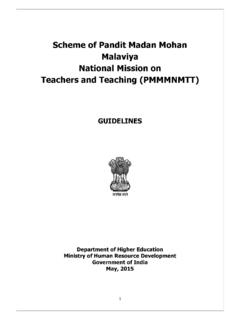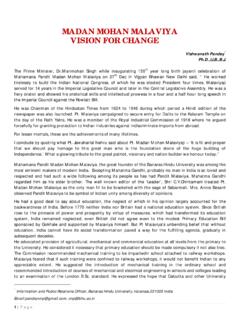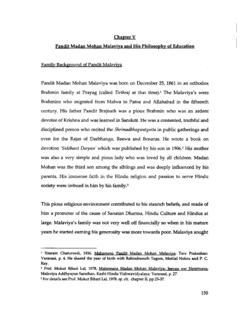Transcription of Malaviya as a Great Visionary for Higher Education ...
1 International Journal of Scientific and Research Publications, Volume 2, Issue 3, March 2012 1 ISSN 2250-3153 Malaviya as a Great Visionary for Higher Education : Celebrating his 150th Birthday Parmanand Singh, Sunita Singh Faculty of Education BHU, Varanasi, INDIA I. INTRODUCTION alaviya Was born on December 25, 1861 and we are celebrating his 150th birth anniversary in this year. The Government has also constituted a committee under the chairmanship of the Prime Minister to celebrate this occasion. Malaviya , a name almost synonymous with Higher Education in the country, has been a Visionary par excellence.
2 While BHU bears testimony to his vision, his views regarding values are perhaps more relevant today, when corruption threatens to shake up the 64-year-old democracy. Mahamana dreamt of creating an ideal scheme of Education which would serve the cause of nation building, rise above narrow sectarian intrests, combine the best in western scientific methods with all that is good and Great in our culture and promote a broad liberation of mind and religious spirit . Every alumnus who passes through the portals of this Great institution carries these seeds of the timeless vision of Mahamana with him. Globalization as we now name it is not an alien concept to our culture.
3 Our seers had this vision of the world as a family even when geographical distance was a formidable barrier to communication. The Indian consciousness has always perceived the world as one family (olq/kSo dqVqEcde). The hallmark of the Indian vision of Education has been openness and acceptance of noble thoughts from all directions while at the same time sending out its own message to the world. As Swami Vivekananda said Like the gentle dew that falls unseen and unheard and yet brings into blossom the fairest of roses, has been the contribution of India to the thought of the world.
4 Silent, unperceived, yet omnipotent in its effect, it has revolutionized the thought of the world yet nobody knows when it did so. Malaviya ji who epitomized Indian values gifted the world with a unique model of integrated, harmonious and balanced Education in the shape of Banaras Hindu University. The motto of Banaras Hindu University, fo|;k e`re uqrs (The end of all knowledge is the attainment of immortality) eloquently reflects the premium placed on Education in our ancient culture. The scheme of Education proposed by Mahamana assumes renewed significance today when Higher Education is facing challenges as never before.
5 It is widely accepted that Higher Education is the basic building block in the creation of an inclusive, equitable and diverse knowledge society. As the final communiqu adopted at the end of World Conference on Higher Education (2009) emphasizes Higher Education must pursue the goals of equity, relevance and quality simultaneously. This is particularly true in today s world where knowledge is gradually emerging as the primary production resource which will determine development or lack of it. The new realities of 21st century have given birth to a host of complex issues and challenges in Higher Education like internationalization, privatization, quality assurance, governance, fostering of research and innovation, competition for human and financial resources etc.
6 The Indian Higher Education system cannot afford to insulate itself from these changes. At the same time it should be able to meet the expectations and challenges of an increasingly globalizing world without endangering local culture and values. Every care should be taken to ensure that the objectives of Higher Education do not become subservient to the forces of the market. The unmet needs of Higher Education demand a paradigm shift in approach, while keeping in mind the parameters of access, equity, quality, relevance and right values. Thus, it is obvious that Higher Education policy will have to reconcile diverse objectives- the short term aims with long term goals, the traditional wisdom with modern innovative thinking and scientific rationality with religiousity and faith.
7 Banaras Hindu University is striving in the direction of proposing a model of Higher Education which would address the challenges of globalization without compromising on national priorities or Indian values. This model of Education would conform to the four pillars of Education identified by the Delors Commission learning to know, learning to do, learning to live together and learning to be. Banaras Hindu University is uniquely placed to undertake this exercise because it symbolizes the Indian heritage of acceptance and integration while at the same time preserving our unique identity. As the scientist Sir Bose observed in his homage on the 70th birth anniversary of Mahamana, The Hindu University will always be a monument of the faith which inspired Pt.
8 Madan mohan Malaviya in his lifelong work for founding the Great centre of learning at Benaras for the advancement of world s knowledge. To be organic and vital, the university must stand primarily for self expression and winning for India, her true place in the Intellectual Federation of Nations . These immortal words are as true for the Banaras Hindu University in particular and the Higher Education system in general today as they were more than three quarters of a century ago. II. HOW MALVIYA JI IDEOLOGY COME IN ACTION, AN OVERVIEW Malaviya ji was born just after the, so called Indian mutiny of next two or three decades following the first world war of freedom the entire country was passing through a national Renaissance in every sphere of life -social, economic, political, religious, and educational.
9 The spirit of many Great sons of this land rose in revolt against the British domination.. Malaviya was one of them .He joined the Indian national congress immediately M International Journal of Scientific and Research Publications, Volume 2, Issue 3, March 2012 2 ISSN 2250-3153 and made his maiden speech before the Great national gathering at its second national session of congress held at Calcutta in 1886 and became an ardent champion of Indian nationalism. During his tours of country in subsequent years while attending the congress session, Malaviya had the opportunity to observe the conditions existing in the country in various spheres.
10 Malaviya therefore came to the conclusion that in order to revitalise India as a nation, it was necessary to feed her youth with the old spiritual and moral food and religion must be the part of Education founded on Indian ideals and enriched with the result achieved by science and learning of the west .Modren Indian Higher Education has its roots in the British rule that began as a speck in establishment of three university of Bombay, Calcutta , Madaras done on the basis of Landan university. Lord Curzon, appointed on Indian Universities commission in 1904 to probe into the working of Indian Universities.



















